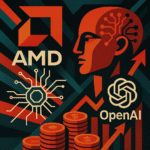Key Points
- Unprecedented Price Surge: DDR4 memory prices have soared, with some chips doubling in price in just two weeks (from $3 USD to $6-8 USD), making it sometimes more expensive than DDR5.
- Supply Squeeze by Major Manufacturers: The main reason for the surge is the strategic exit of top DRAM makers (Samsung, SK Hynix, Micron, 长鑫存储) from DDR4 production, with their combined global DRAM supply expected to be over 95% in 2024.
- AI’s Impact (HBM): The booming demand for High Bandwidth Memory (HBM) for AI applications has caused major manufacturers to shift production, leading to a “capacity displacement effect” where HBM production takes up a significant portion of their memory capacity (e.g., Micron 26%).
- DDR4 Still Relevant: Despite DDR5, DDR4 is projected to have 20-30% market penetration in PC and server markets in 2025 due to compatibility with certain CPUs.
- Opportunity for Chinese Domestic Brands: The supply vacuum created by international companies has opened opportunities for Chinese memory firms like 长鑫存储, 兆易创新, and 江波龙, who are actively pushing domestic solutions in markets like 华强北.

The recent surge in DDR4 memory prices has caught everyone off guard, and the story starts on the ground in China’s sprawling electronics markets.
“We didn’t stock up on DDR4, and by the time we reacted, our inventory was almost cleared out.”
That’s the word from a Shenzhen-based storage sales agent, and it perfectly captures the market’s shock.
In just two weeks, the price of some DDR4 chips has doubled.
In some cases, the older DDR4 tech is now even more expensive than its successor, DDR5.
We’re seeing a classic supply and demand squeeze, driven by major manufacturers cutting production and a surprising uptick in demand.
Let’s dive into what’s happening in Shenzhen’s legendary Huaqiangbei (华强北) electronics market and what’s driving this wild market shift.

Resume Captain
Your AI Career Toolkit:
- AI Resume Optimization
- Custom Cover Letters
- LinkedIn Profile Boost
- Interview Question Prep
- Salary Negotiation Agent

The Great DDR4 Price Inversion: Older Tech, Higher Price Tag?
It sounds counterintuitive, right? A newer, better, faster technology should cost more.
But in the world of memory chips, we’re seeing a “price inversion” where the older DDR4 is sometimes more expensive than DDR5.
For a quick refresh:
- DDR4 (Double Data Rate 4): A mainstream standard for PCs and servers, with chip capacities up to 16GB.
- DDR5 (Double Data Rate 5): The new kid on the block, offering faster speeds, more bandwidth, lower power consumption, and single-chip capacities up to 64GB.
A Look at the Shocking Price Jumps
A storage agent laid out the numbers, and they are staggering.
Some DDR4 chip models leaped from $3 USD (about ¥21.80 RMB) to $6-8 USD (about ¥43.60-¥58.10 RMB) in just the last couple of weeks.
The agent notes, “The off-season has become a busy season. Customers ask ‘Are you crazy?’ every time they see the quote.”
It’s not just the individual chips. The memory modules themselves are seeing massive hikes:
- A premium international brand 16GB DDR4 memory module in Huaqiangbei can cost up to ¥380 RMB (about $52.10 USD).
- Even used modules are fetching over ¥200 RMB (about $27.40 USD).
- New DDR4 modules are almost impossible to find for under ¥300 RMB (about $41.10 USD).
The price surge is so dramatic that some Huaqiangbei merchants are advising customers to just buy DDR5 if their hardware is compatible.
Why DDR4 Still Matters in a DDR5 World
Even with DDR5 taking over, DDR4 isn’t dead yet. Not by a long shot.
According to Xu Jiayuan (许家源), an analyst at TrendForce, DDR4 still has a solid grip on the market.
In 2025, DDR4 penetration is estimated to be:
- 20%-30% in the PC and server markets.
- DDR5 penetration is projected to be around 70%-80%.
“For PC and server applications, some Intel Raptor Lake and Ice Lake CPUs only support DDR4, so they are more amenable to price increases from original manufacturers,” Xu explains.
The price hike isn’t expected to slow down anytime soon. The upward trend for DDR4 is likely to continue at least until the third quarter of 2025.
This is fueled by steady demand from cloud service providers beefing up their AI server builds and PC makers stockpiling ahead of potential tariffs.
However, there are signs things might be cooling off. The market is showing a “price-but-no-market” dilemma, where prices are high, but transactions are slowing down.
As one agent put it, “Like gold, everyone buys when prices are rising, not when they’re falling… It’s time to be cautious when acquiring DDR4 now, for fear of being the last one to buy in.”

The Real Reason for the Surge: A Classic Supply Squeeze
The recent DDR4 price madness all comes down to the upstream manufacturers who control the supply.
The memory chip industry is a highly concentrated market, and when the big players decide to shift strategy, everyone feels it.
Longsys (Jiangbolong 江波龙) confirmed that original manufacturers are strategically exiting the DDR4 business, just as demand from the server market is growing.
Meet the Big Three: Samsung, SK Hynix, and Micron
The DRAM market is dominated by a few key players. In 2024, their combined global DRAM supply is expected to be over 95%.
- Samsung
- SK Hynix
- Micron Technology (Meiguang Keji 美光科技)
When these giants adjust their production capacity, the market reacts.
Here’s a timeline of the production cuts:
- April 2025: Samsung reportedly decided to slash DDR4 production.
- Also in April: SK Hynix announced plans to cut its DDR4 capacity to below 20% of its total output, with a full stop planned for April 2026.
- May 2025: China’s own ChangXin Memory Technologies (Changxin Cunchu 长鑫存储) reportedly stopped DDR4 production.
- June 2025: Micron’s EVP Sumit Sadana publicly confirmed plans to discontinue DDR4 for most PC and data center customers, focusing only on long-term clients in automotive, industrial, and communications.
Micron’s official confirmation was the final match that lit the fire, sending the DDR4 market into a frenzy.
The HBM Effect: How AI is Devouring Memory Capacity
There’s another massive factor at play: the rise of Artificial Intelligence and its insatiable hunger for High Bandwidth Memory (HBM).
HBM is the gold-standard memory for powering AI compute.
As tech giants pour resources into AI, memory manufacturers are shifting their production lines to meet the demand for HBM.
This creates a “capacity displacement effect.”
According to TrendForce, HBM production now accounts for a significant portion of the big three’s memory capacity:
- Samsung: 23%
- SK Hynix: 18%
- Micron: 26%
Manufacturing HBM and DDR5 is simply more profitable right now. As a result, production capacity for the older, less profitable DDR4 gets squeezed, leading to reduced supply and, you guessed it, higher prices.

Find Top Talent on China's Leading Networks
- Post Across China's Job Sites from $299 / role, or
- Hire Our Recruiting Pros from $799 / role
- Qualified Candidate Bundles
- Lower Hiring Costs by 80%+
- Expert Team Since 2014
Your First Job Post

China’s Answer: The Rise of Domestic Memory Giants
- ChangXin Memory Technologies (CXMT / 长鑫存储): Counterpoint predicts 50% year-on-year DRAM shipment growth, with market share climbing from 6% to 8% by end of 2025. Actively pushed by Huaqiangbei merchants as a domestic alternative.
- GigaDevice (Zhaoyi Chuangxin / 兆易创新): Partnering with ChangXin, expanding DRAM business. Transactions between the two expected to hit ¥1.161 billion RMB (approx. $159.2 million USD) in 2025.
- Longsys (Jiangbolong / 江波龙): Major domestic memory manufacturer leveraging strong relationships with wafer suppliers to navigate market shifts.
- Dosilicon (Dongxin Gufen / 东芯股份): Ramping up capacity for niche DRAM products to capture market share as overseas competitors exit.
- Dawa Technology (Dawei Keji / 大为科技): Stated its subsidiary’s DDR4 and LPDDR4X are mainstream solutions and they are managing prices based on market conditions.
- Montage Technology (Lanqi Keji / 澜起科技): A-share memory interface chip company. In DDR5 “harvest period” with Q1 net profit soaring 135.14% year-on-year to ¥525 million RMB (approx. $72.0 million USD) due to increasing DDR5 penetration.
This supply squeeze from international giants has created a massive opportunity for China’s domestic semiconductor industry.
Huaqiangbei’s New Pitch: “Have You Considered Domestic?”
Walking through Huaqiangbei today, you’ll hear a new sales pitch.
“Would you consider domestic brands? The memory chips are no less inferior to international original manufacturers, and the cost-performance ratio is also higher.”
Merchants are actively pushing DDR4 modules built with chips from domestic players like ChangXin Memory Technologies (Changxin Cunchu 长鑫存储).
For the same specs, these domestic modules can be about ¥100 RMB (about $13.70 USD) cheaper than their international counterparts.
Meet the Players: China’s A-Share Storage Companies
The market is taking notice. Counterpoint predicts ChangXin Memory Technologies’ DRAM shipments will grow 50% year-on-year, with its market share climbing from 6% to 8% by the end of 2025.
Here’s how other Chinese firms are responding:
- GigaDevice (Zhaoyi Chuangxin 兆易创新): Partnering with ChangXin, GigaDevice is expanding its DRAM business, with transactions between the two expected to hit ¥1.161 billion RMB (approx. $159.2 million USD) in 2025.
- Longsys (Jiangbolong 江波龙): As a major domestic memory manufacturer, they’re leveraging their strong relationships with wafer suppliers to navigate the market shifts.
- Dosilicon (Dongxin Gufen 东芯股份): Is ramping up capacity for its niche DRAM products, aiming to capture market share as overseas competitors exit.
- Dawa Technology (Dawei Keji 大为科技): Stated that its subsidiary’s DDR4 and LPDDR4X are mainstream solutions and they are managing prices based on market conditions.
While this is happening, A-share memory interface chip company Montage Technology (Lanqi Keji 澜起科技) is already in its DDR5 “harvest period.”
With DDR5 penetration increasing, the company’s Q1 net profit soared 135.14% year-on-year to ¥525 million RMB (approx. $72.0 million USD).
The bottom line is clear: The global shift away from DDR4 is creating a power vacuum, and Chinese tech companies are stepping up to fill it.
What we’re witnessing is a perfect storm of production cuts, AI-driven demand shifts, and a blossoming domestic industry, all culminating in the wild swings in DDR4 memory prices we see today.

ExpatInvest China
Grow Your RMB in China:
- Invest Your RMB Locally
- Buy & Sell Online in CN¥
- No Lock-In Periods
- English Service & Data
- Start with Only ¥1,000


![China EV Sales April 2025: Leapmotor Crushes It, NIO Surges, Xiaomi Slips Slightly [FreshFromChina]](https://freshfromchina.com/wp-content/uploads/2025/05/China-EV-Sales-April-2025-Leapmotor-Crushes-It-NIO-Surges-Xiaomi-Slips-Slightly___FreshFromChina-150x150.png)


